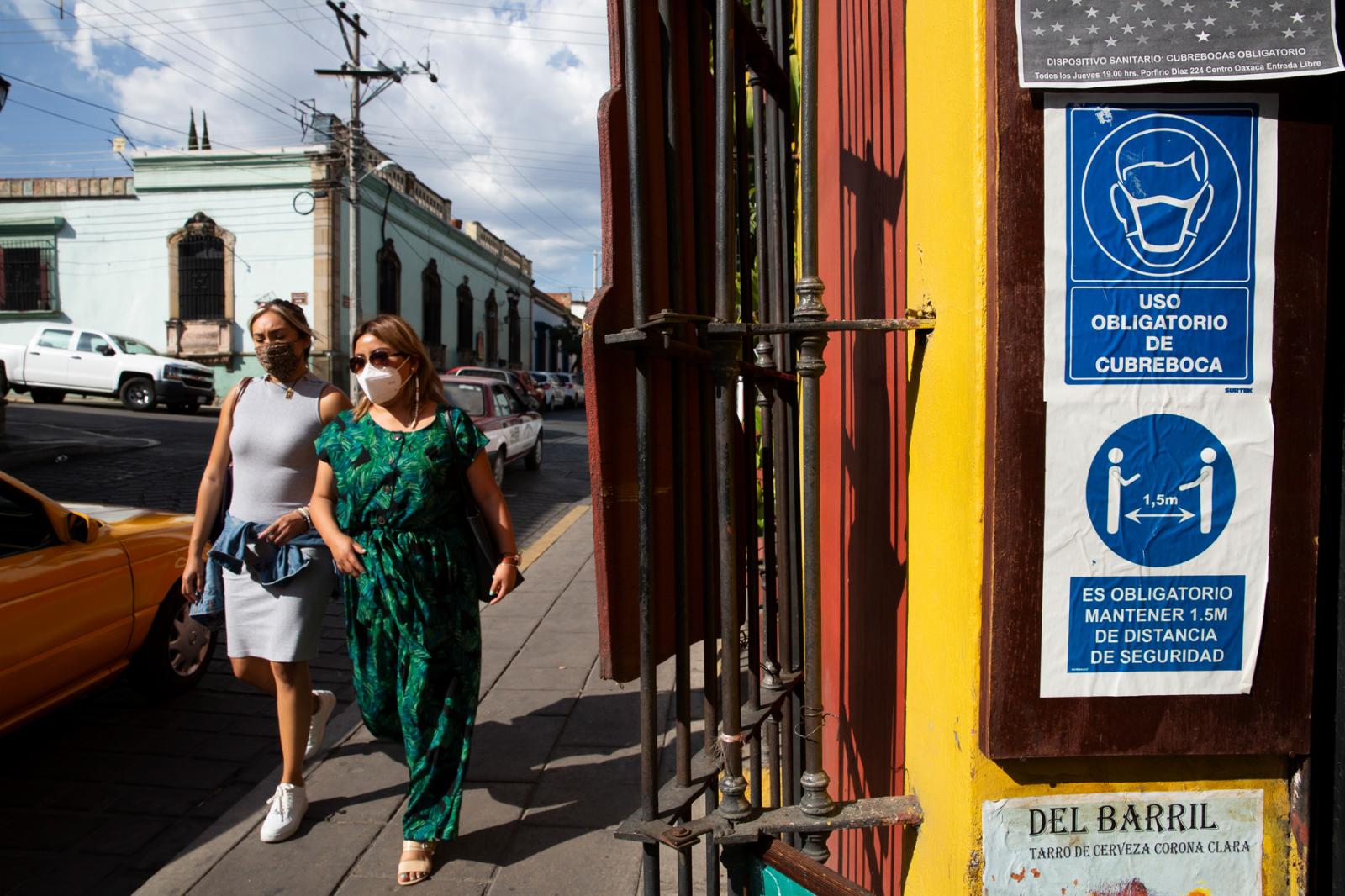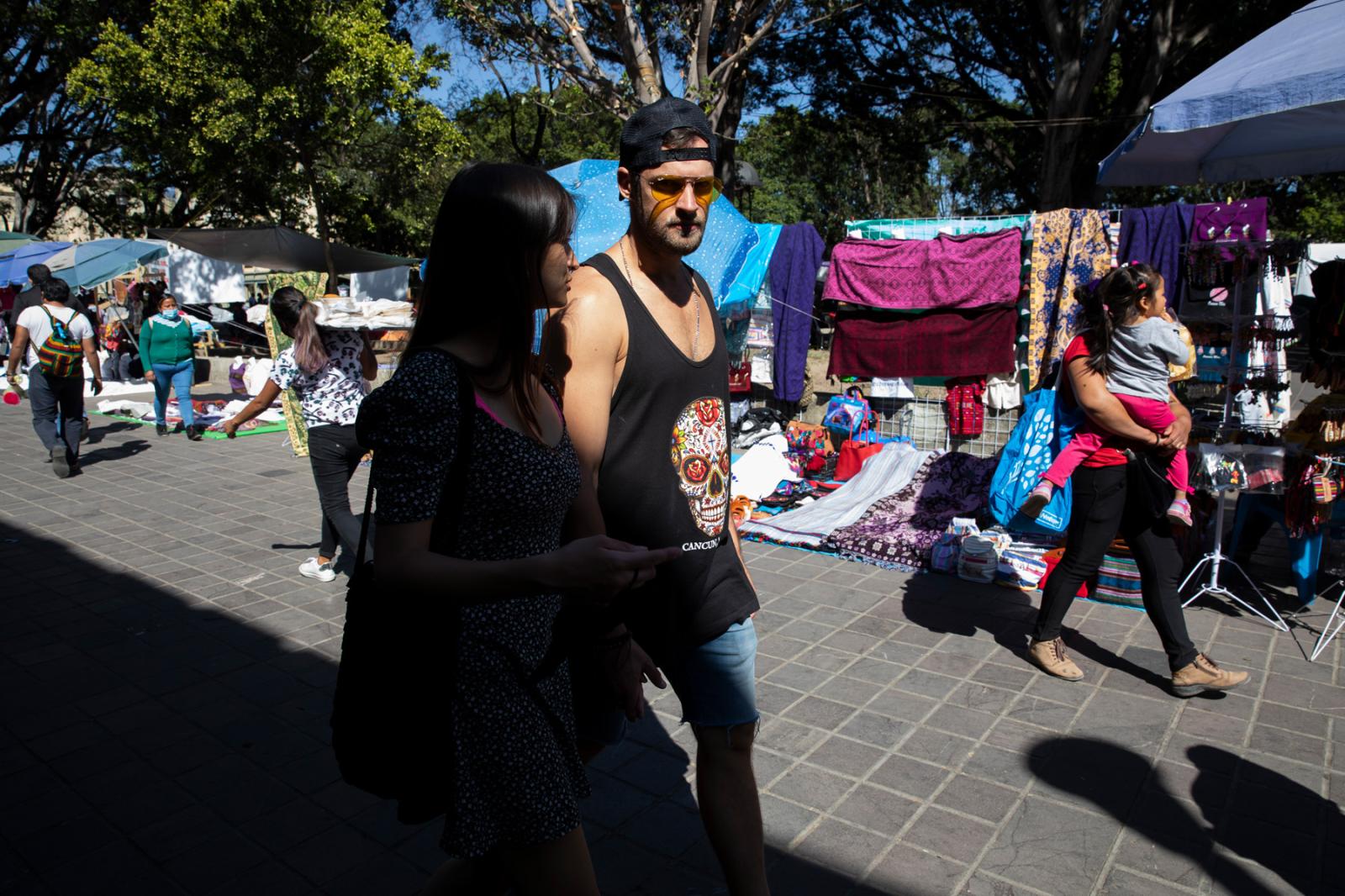Tourists are welcome in Oaxaca, Mexico. Their increasingly bad behavior is not.
Washington Post.February 26, 2021 at 1:18 p.m. EST
Photographs by Eva Lepiz.
It’s been more than a month since Frank Coronado got covid-19, but the photographer from Oaxaca, Mexico, still gasps for air when he speaks sometimes. Although his illness didn’t put him in the hospital, his case was severe enough that he worried about suffocating in his sleep.
Coronado’s personal experience with the coronavirus has made the Oaxaca native sensitive to the pandemic situation in the state. As he watched case numbers continuing to rise, he also noticed more tourists defying widely practiced public-health protocols, like wearing face masks in public.
On Feb. 25, Coronado posted a plea to his 171,000 Instagram followers: “Dear travelers, you are welcome in Oaxaca, but you should ALWAYS wear a mask when you are in public places.”
He wanted to publicly address the issue and encourage visitors to do better — particularly foreigners who travel from Oaxaca City into smaller rural villages, where artisans are even more vulnerable.
“I get mad because I already went through [covid-19] and know how bad it feels,” Coronado says. “I don’t want my people, the people of Oaxaca, to get sick.”
Unlike many of the world’s most-frequented tourism hot spots, Mexico never fully closed to foreign visitors. While the Centers for Disease Control and Prevention has said Americans should avoid all travel to Mexico because of “very high level” of coronavirus, the country has remained one of the most popular destinations throughout the pandemic.
Still, Mexico tourism plummeted last spring as it did around the globe; according to reports from the state government, Oaxaca recorded less than half of its 2019 visitor arrival numbers in 2020. Numbers picked up again last summer, but welcoming outsiders back as the pandemic continues to rage has been complicated.
While Oaxaca doesn’t pull in nearly as many visitors as Mexican destinations such as Cancún, Acapulco or Mexico City, tourism is a significant part of its economy. Those who work in the industry have suffered in its wake.
Gabriel Sánchez, a Oaxaca native who started a private tour company 2½ years ago, says the abrupt end of tourism last March was overwhelming. He survived on savings when visitors disappeared, and he watched as other guides were forced to take measures like selling their cars to make ends meet.
With business trickling back, Sánchez is elated. He took coronavirus prevention courses by the Mexican Institute of Social Security (IMSS) and guided his first tour again on Oct. 20. Now he follows precautions such as checking guests’ temperatures, requiring face masks, social distancing and providing hand sanitizer. He also helps Americans get their mandatory coronavirus tests.
Most of his returning customers have complied with his safety protocols. But that’s not the case with all of the tourists he sees around town. Like the Americans who refused to wear a mask at the request of an ice cream vendor, or the people who regularly break coronavirus rules at Monte Albán, Oaxaca’s most famous archaeological site.
“As soon as they go through the checkpoint, 30 steps after that, they take their masks off,” Sánchez says. “And most of them are foreigners.”
Beyond Monte Albán and Oaxaca City, Oaxaca’s artisan culture is one of its strongest selling points. It’s common for tourists to take day trips out to remote villages to see how the state’s famed mezcal, arts and crafts are made. With little access to medical care, those communities have been particularly vulnerable during the pandemic. Many closed to outsiders to protect themselves, but some have started welcoming back visitors for income despite the risk involved.
Omar Alonso, who has been running food and mezcal tours in Oaxaca for seven years, believes visiting rural communities can be done safely with the small private groups he carefully vets ahead of time. But unfortunately, he regularly runs into the kinds of tourists he fears.
For example, in the mountain town of San José Del Pacifico between Oaxaca City and the beach, Alonso says he often sees maskless foreigners.
“If you are going through a town where there’s locals and older people serving you food because that’s what they do for a living, it’s very frustrating because [foreigners] don’t respect them,” says Alonso, whose uncle passed away from covid-19. “I can tell you that yesterday, when we went to have lunch, out of the maybe 20 tourists that we saw walking around town, maybe two of them had a mask.”
Vera Claire, a U.S. expat whose nonprofit Cosa Buena works with local Indigenous communities to preserve their artistic traditions, says she believes some tourists’ perception of Mexico may be the problem.
“I think there’s a stereotype of [Mexico] being a place with no rules, a place to have fun and relax and enjoy yourself,” she says. She regularly receives messages on social media or emails from strangers asking for Oaxaca travel advice, noting that they need to get away and forget about their lives in the United States for a while, she says.
“That’s a really dangerous narrative, of course, because they come here with that mentality that there’s no rules,” Claire says. “Those of us who are foreigners living here all have a responsibility of shedding light on the severity of the situation … Mexico is beautiful. It’s a wonderful place to escape to. But the same thing is happening here.”
Living in Oaxaca City, Claire says the frequency of spotting maskless tourists is increasing, despite the prevalence of signs encouraging masks and most locals complying with the practice. It’s unsettling as the coronavirus seems to be encroaching on her community.
It’s impossible to know exact case numbers in the area as testing is limited. However, it was reported in January that hospitalizations in Oaxaca for covid-19 were rising rapidly, with 13 hospitals in the state at full capacity and facing a desperate oxygen tank shortage (an issue plaguing more than Oaxaca).
“The health-care system here is minimal at the best of times, especially for poor people who rely on the public health system,” says Suzanne Barbezat, who runs the company Discover Oaxaca Tours with her husband, Benito Hernández. “Having those resources used up, it’s scary.”
Vicente Reyes, a Oaxaca native and president of social impact collective Hermano Maguey, which works on promoting an equitable agave ecosystem in the region, says he thinks travelers would behave differently if they knew about Oaxaca’s hospital crisis.
“It’s a dramatic situation and it’s not something tourists are seeing,” he says. “This is a harsh reality that doesn’t show up on Instagram.”
Reyes feels like the worst offenders are young tourists. He has watched them come from around the world to travel along a well-worn party circuit through Mexico City, Tulum and Oaxaca, attending huge, mask-free gatherings and putting locals at risk as a result.
“It sends a really sad, de-motivating message to locals who are taking care of each other,” Reyes says. “We are all trying to keep it together, and these guys are flying around the city, enjoying themselves and not taking care of us.”
Many in Oaxaca City don’t have the luxury of isolating from tourists — such as Aurora Tostado, who owns the downtown coffee shop Marito & Moglie with her husband.
“People in Mexico, we have to get out of our homes to work. It’s not like we can work remotely like most of the people in the U.S.,” Tostado says.
The couple made adjustments to Marito & Moglie, moving more tables to an outside patio and encouraging customers to keep masks on and social distance. Insisting on safety protocols is something that makes her and her employees feel more comfortable at work, and something most guests appreciate — but Tostado notices others around town behaving like the pandemic is over. “This is not Disneyland,” she would like to tell them.
Like others in Oaxaca hospitality, Tostado benefits financially from having tourists, and she is happy to welcome them back, she says. She just hopes they will consider the chain reaction of their behavior as they enjoy the culture that makes her city special. Seeing travelers come to town to party doesn’t bother her for the party itself. It’s the party’s ramifications.
“The same people are going to go have breakfast at the market, and the old lady that is working, because she has to work, is going to get infected because of their [choices],” Tostado says. “I would say, yes, come, the nice weather is here. But be responsible.”
 Tourists are welcome in Oaxaca, Mexico. Their increasingly bad behavior is not.
Tourists are welcome in Oaxaca, Mexico. Their increasingly bad behavior is not. “I would say, yes, come, the nice weather is here. But be responsible."
Washingtonpost.com













